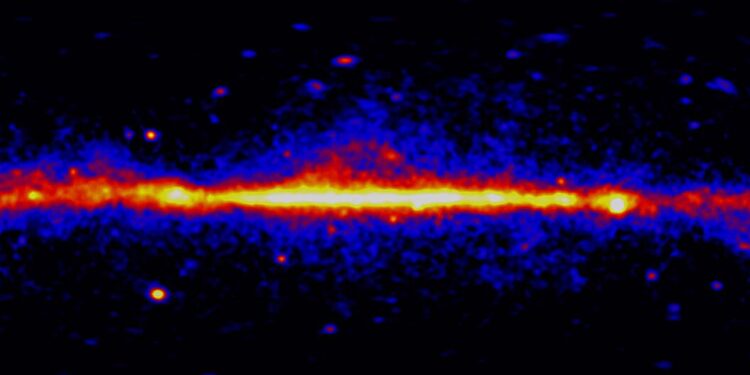Credit: NASA
The cosmos comes to life in a time-lapse film made entirely from 14 years of data acquired by NASA’s Fermi Gamma-ray space telescope. Our sun, occasionally rising, serenely traces its path across the sky against a backdrop of high-energy sources within our galaxy and beyond.
“The Milky Way’s bright, constant gamma-ray glow is punctuated by intense, days-long eruptions of near-light-speed jets propelled by supermassive black holes at the hearts of distant galaxies,” said Seth Digel. , senior scientist. at SLAC National Accelerator Laboratory in Menlo Park, California, which created the images. “These spectacular flares, which can appear anywhere in the sky, occurred millions or even billions of years ago, and their light barely reaches Fermi before our eyes.”
Gamma rays are the most energetic form of light. The film shows the intensity of gamma rays with energies above 200 million electron volts detected by Fermi’s Large Area Telescope (LAT) between August 2008 and August 2022. For comparison, visible light has energies between 2 and 3 electron volts. Brighter colors mark the locations of the most intense gamma ray sources.
“One of the first things that strikes your attention in the film is a source that traces a constant arc across the screen. It is our sun, whose apparent movement reflects the annual orbital movement of the Earth around him,” said Fermi deputy project scientist Judy Racusin, who recounts a tour of the film, at NASA’s Goddard Space Flight Center in Greenbelt, Maryland.
Most of the time, the LAT faintly detects the sun using accelerated particles called cosmic rays, atomic nuclei moving at close to the speed of light. When they hit solar gas or even the light it emits, gamma rays result. Sometimes, however, the sun suddenly brightens in powerful flares called solar flares, which can briefly make our star one of the brightest sources of gamma rays in the sky.
The film shows the sky from two different views. The rectangular view shows the entire sky with the center of our galaxy in the middle. This highlights the central plane of the Milky Way, which glows under gamma rays produced by cosmic rays hitting interstellar gas and starlight. It is also dotted with many other sources, including neutron stars and supernova remnants. Above and below this central band, we look out of our galaxy and into the larger universe, dotted with light sources and changing rapidly.
Most of them are actually distant galaxies, and they are best seen in a different view centered on the north and south poles of our galaxy. Each of these galaxies, called blazars, hosts a central black hole with a mass of a million suns or more.
One way or another, black holes produce extremely fast jets of matter, and with blazars we are looking almost directly into one of these jets, a view that enhances their brightness and variability.
“The variations tell us that something has changed in these planes,” Racusin said. “We regularly monitor these sources and alert other telescopes, in space and on the ground, when something interesting happens. We need to be fast to catch these flares before they disappear, and the more we can collect observations, the better we can.” I will be able to understand these events.
Fermi plays a key role in the growing network of missions working together to capture these changes in the universe as they unfold.
Many of these galaxies are extremely distant. For example, light from a blazar known as 4C +21.35 has been traveling for 4.6 billion years, meaning that an eruption we observe today actually occurred while our sun and our solar system were beginning to form. Other bright blazars are more than twice as distant and together provide striking snapshots of black hole activity throughout cosmic time.
Many short-lived events studied by Fermi, such as gamma-ray bursts, the most powerful cosmic explosions, are not visible in the time-lapse. This is the result of processing data over several days to refine the images.
The concept of the LAT was invented at SLAC, the instrument was assembled and tested at SLAC, which was also responsible for the electronics and flight software, and SLAC continues to process the newly transmitted data several times per day.
The Fermi Gamma-ray Space Telescope is an astrophysics and particle physics partnership managed by Goddard. Fermi was developed in collaboration with the U.S. Department of Energy, with significant contributions from academic institutions and partners in France, Germany, Italy, Japan, Sweden and the United States.
Provided by SLAC National Accelerator Laboratory
Quote: Fermi mission creates 14-year time-lapse of gamma-ray sky (December 20, 2023) retrieved December 20, 2023 from
This document is subject to copyright. Apart from fair use for private study or research purposes, no part may be reproduced without written permission. The content is provided for information only.



